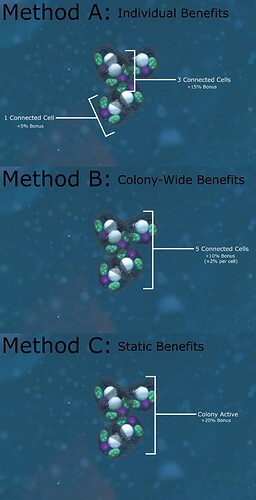With the implementation of binding agents now complete, we have found ourselves facing the question of how extensive the benefits they provide should be. I have already brought this up before, but I decided to continue the discussion here so we can refer to it more easily in the future.
The primary things we need to consider here are what benefits binding agents already provide, what they should provide, and how they should be distributed between colony members.
Present Benefits
Forming a colony in Thrive right now already provides some nice benefits that I feel quite pleased with.
First of all, adhering to a cell grants the player an extended reach for gathering resources and capturing prey without overbearing speed penalties, which as it currently stands, might be a bit too unbalanced due to the lack of physics constraints.
In addition to that, colony members provide an effective buffering armor against environmental hazards and predators, with the player being able to disband the colony and escape with the predators distracted by the player’s peers. I wonder how that strategy would hold up if player species death detracted from player populations…
Potential Benefits
In the event that the above benefits feel particularly lacking, I have come up with a few potential benefits we could implement as a feature for colonies, as well as including some ideas I have seen tossed around by others.
- Increased healing rate due to the cells sharing their resources.
- Decreased osmoregulation cost due to less exposed surface area
- Increased effective engulfment size, allowing the colony to engulf larger objects using their collective power (This one might be problematic to implement)
- Increased camera zoom, though this might become problematic with spawn radius…
This is all I have at the moment, feel free to provide your own ideas on what binding agents might provide if you have any.
Distribution Methods
The final thing I would like to go over is how the less abstract benefits might be distributed between cells, and how member count might effect them as well.
There are three primary methods I have devised through which value-based benefits might scale with cell-count, if at all.
Method A:
By making cells experience benefits based on the amount of adjacently connected members, we can encourage more strategic member placement. This would also help prevent benefits from scaling beyond belief. However, this might only be frustrating due to the lack of control players currently have on unbound cells, and how they may face difficulty in getting them positioned just right. It may also be a more difficult and time consuming method to program and debug.
Method B:
By granting a colony-wide bonus to all cells based on the total amount of members in the colony, we can encourage players to form ever larger colonies without worrying about cell placement. However, we will either need to limit the bonuses with a hard cap or diminishing returns to prevent the benefits from becoming too great.
Method C:
Applying the benefits as a flat bonus on the basis of a cell being in a bound state or not would likely be the easiest and least resource intensive route to take, but doing so would not incentivize forming larger cell colonies on it’s own.
Personally I think I prefer method A the most for balancing purposes but I fear it might be problematic to implement, as well as frustrating to handle cell positioning…
If anyone has any ideas on how else we might do this please feel free to comment.
I would also like to know which method is most desirable.
